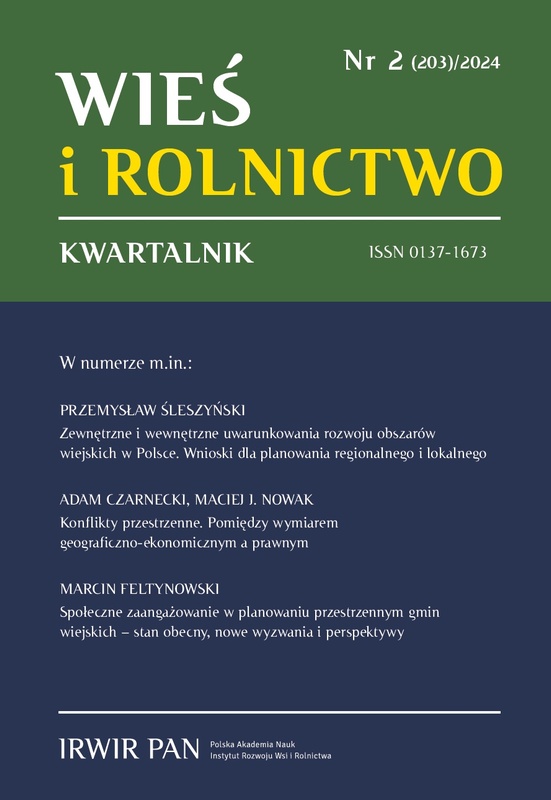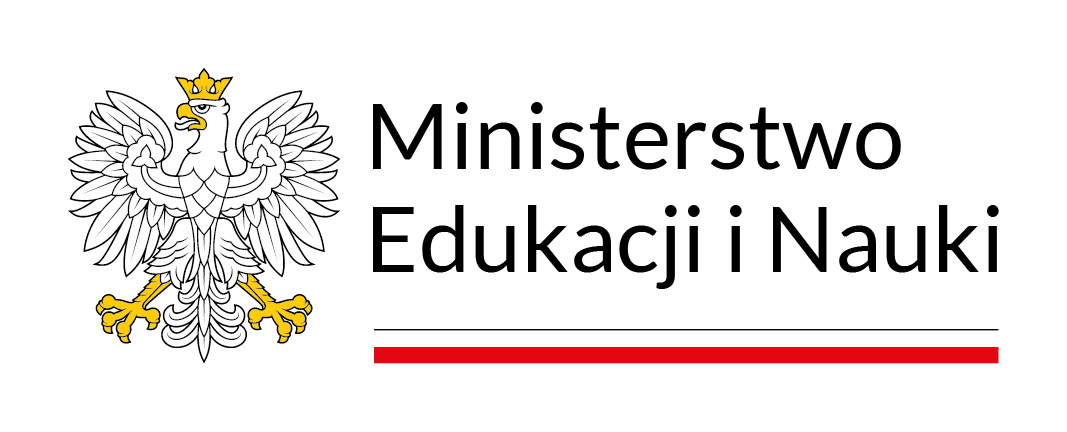Społeczne zaangażowanie w planowaniu przestrzennym gmin wiejskich – stan obecny, nowe wyzwania i perspektywy
DOI:
https://doi.org/10.53098/wir.2024.2.203/03Słowa kluczowe:
partycypacja społeczna, zmiana ustawy o planowaniu przestrzennym, konsultacje społeczne, geoankieta, podejmowanie decyzjiAbstrakt
Planowanie przestrzenne stanowi podstawową politykę należącą do zadań własnych samorządów lokalnych. Każdy samorząd, w tym gminy wiejskie, powinny włączać aktorów lokalnych w procesy konsultacyjne. Zmiana przepisów z zakresu planowania przestrzennego eksponuje istotę partycypacji społecznej. Podkreśla się w nich znaczenie narzędzi geopartycypacyjnych, które stanowić mają wsparcie dla wykorzystywanych dotychczas tradycyjnych metod konsultacji. Celem artykułu było wskazanie poziomu partycypacji w obecnym kształcie, co może stanowić punkt wyjścia do dalszych badań, gdy upowszechnione zostaną nowe metody partycypacji. Dodatkowo dokonano analizy przestrzennego zróżnicowania partycypacji w kreowaniu polityk przestrzennych gmin wiejskich. Na kanwie prowadzonych badań można było wskazać jednostki samorządu terytorialnego udostępniające dokumentację procesu planistycznego na stronach internetowych, jak również te, które pomijają ten aspekt informacyjny. Postawione cele wpisywały się w wykorzystaną metodologię opartą na szczegółowej analizie stron internetowych gmin wiejskich województwa łódzkiego. W szczególności obejmowała ona uchwały rad gmin oraz zarządzeń wójtów. Ponadto ocenie podlegała dostępność dokumentów związanych z konsultacjami poprzez geoportale gminne. Uzyskane wyniki pozwoliły na wskazanie, że wśród 72,8% badanych gmin możliwy był do określenia poziom zaangażowania aktorów lokalnych w proces sporządzania studium uwarunkowań i kierunków zagospodarowania gminy.
Bibliografia
Aitken M. (2010). A three-dimensional view of public participation in Scottish land-use planning: Empowerment or social control? Planning Theory, 9 (3), 248–264. DOI: https://doi.org/10.1177/1473095210366193
André P., Enserink B., Connor D., Croal P. (2006). Public Participation International Best Practice Principles. Seria: Special Publication Series, 4. Fargo, USA: International Association for Impact Assessment.
Arnstein S.R. (1969). A ladder of citizen participation. Journal of the American Institute of Planners, 35 (4), 216–224. DOI: https://doi.org/10.1080/01944366908977225
Bednaříková Z. (2012). Participation of active seniors in rural areas in public life. European Countryside, 4 (3), 208–216. DOI: https://doi.org/10.2478/v10091-012-0024-5
Billger M., Thuvander L., Wästberg B.S. (2017). In search of visualization challenges: The development and implementation of visualization tools for supporting dialogue in urban planning processes. Environment and Planning B: Urban Analytics and City Science, 44 (6), 1012–1035. DOI: https://doi.org/10.1177/0265813516657341
Bizjak I. (2012). Improving public participation in spatial planning with Web 2.0 tools. Urbani Izziv, 23 (1), 112–124. DOI: https://doi.org/10.5379/urbani-izziv-en-2012-23-01-004
Brown G. (2015). Engaging the wisdom of crowds and public judgement for land use planning using public participation geographic information systems. Australian Planner, 52 (3), 199–209. DOI: https://doi.org/10.1080/07293682.2015.1034147
Brown G., Kyttä M. (2014). Key issues and research priorities for public participation GIS (PPGIS): A synthesis based on empirical research. Applied Geography, 46, 122–136. DOI: https://doi.org/10.1016/j.apgeog.2013.11.004
Cliff A.D., Ord K. (1970). Spatial autocorrelation: A review of existing and new measures with applications. Economic Geography, 46, 269–292. DOI: https://doi.org/10.2307/143144
Egoz S., Jorgensen K., Ruggeri D. (2018). Making the case for landscape democracy: Context and nuances. W: S. Egoz, K. Jorgensen, D. Ruggeri (red.). Defining Landscape Democracy: A Path to Spatial Justice (s. 61–70). Cheltenham: Edward Elgar Publishing. DOI: https://doi.org/10.4337/9781786438348.00015
Eiter S., Vik M.L. (2015). Public participation in landscape planning: Effective methods for implementing the European Landscape Convention in Norway. Land Use Policy, 44, 44–53. DOI: https://doi.org/10.1016/j.landusepol.2014.11.012
Elwood S., Ghose R. (2001). PPGIS in community development planning: Framing the organizational context. Cartographica: The International Journal for Geographic Information and Geovisualization, 38 (3–4), 19–33. DOI: https://doi.org/10.3138/R411-50G8-1777-2120
Fajrillah F., Mohamad Z., Novarika W. (2018). Smart city vs smart village. Jurnal Mantik Penusa, 22 (1), 1–6. DOI: https://doi.org/10.31227/osf.io/r3j8z
Feltynowski M. (2023a). Technological challenges associated with land-use policies in Polish cities and towns. Acta Scientiarum Polonorum Administratio Locorum, 22 (1), 33–43. DOI: https://doi.org/10.31648/aspal.8090
Feltynowski M. (2023b). Urban green spaces in land-use policy – types of data, sources of data and staff – the case of Poland. Land Use Policy, 127, 106570. DOI: https://doi.org/10.1016/j.landusepol.2023.106570
Fritsch M., Kahila P., Németh S., Scott J.W. (2024). Spatial Justice and Cohesion: The Role of Place-Based Action in Community Development. New York: Routledge. DOI: https://doi.org/10.4324/9781003229681
Goodchild M.F. (1986). Spatial Autocorrelation. Geo Books.
Gordon W.M., Robbie J. (2020). Social control of land use. W: W.M. Gordon, S. Wortley. Scottish Land Law (t. 2). London: Sweet and Maxwell.
Guo Y., Wang Y. (2020). Research on Public Participation in Recording Intangible Cultural Heritage in Rural Area. SHS Web of Conferences, 86, 01014. DOI: https://doi.org/10.1051/shsconf/20208601014
Haklay M., Jankowski P., Zwoliński Z. (2018). Selected modern methods and tools for public participation in urban planning: A review. Quaestiones Geographicae, 37 (3), 127–149. DOI: https://doi.org/10.2478/quageo-2018-0030
Hophmayer-Tokich S., Krozer Y. (2008). Public participation in rural area water management: Experiences from the North Sea countries in Europe. Water International, 33 (2), 243–257. DOI: https://doi.org/10.1080/02508060802027604
Jankowski P., Forss K., Czepkiewicz M., Saarikoski H., Kahila M. (2022). Assessing impacts of PPGIS on urban land use planning: Evidence from Finland and Poland. European Planning Studies, 30 (8), 1529–1548. DOI: https://doi.org/10.1080/09654313.2021.1882393
Jian I.Y., Luo J., Chan E.H.W. (2020). Spatial justice in public open space planning: Accessibility and inclusivity. Habitat International, 97. DOI: https://doi.org/10.1016/j.habitatint.2020.102122
Kahila-Tani M., Kytta M., Geertman S. (2019). Does mapping improve public participation? Exploring the pros and cons of using public participation GIS in urban planning practices. Landscape and Urban Planning, 186, 45–55. DOI: https://doi.org/10.1016/j.landurbplan.2019.02.019
Kalisiak-Mędelska M. (2015). Partycypacja społeczna na poziomie lokalnym jako wymiar decentralizacji administracji publicznej w Polsce. Łódź: Wydawnictwo Uniwersytetu Łódzkiego. DOI: https://doi.org/10.18778/7969-412-9
Knudtzon L. (2018). Democratic theories and potential for influence for civil society in spatial planning processes. W: S. Egoz, K. Jorgensen, D. Ruggeri (red.). Defining Landscape Democracy: A Path to Spatial Justice (s. 3–15). Cheltenham: Edward Elgar Publishing. https://china.elgaronline.com/edcollchap/edcoll/9781786438331/9781786438331.00010.xml (dostęp: 24.01.2024).
Kozłowska-Woszczycka A., Pactwa K. (2024). Diagnosis of the Walbrzych post-mining area: Pilot study using social participation. The Extractive Industries and Society, 17, 101401. DOI: https://doi.org/10.1016/j.exis.2023.101401
Kyttä M., Randrup T., Sunding A., Rossi S., Harsia E., Palomäki J., Kajosaari A. (2023). Prioritizing participatory planning solutions: Developing place-based priority categories based on public participation GIS data. Landscape and Urban Planning, 239, 104868. DOI: https://doi.org/10.1016/j.landurbplan.2023.104868
Leibenstein H. (1950). Bandwagon, Snob, and Veblen Effects in the Theory of Consumers’ Demand. The Quarterly Journal of Economics, 64 (2), 183–207. DOI: https://doi.org/10.2307/1882692
Mevono Mvogo D. (2023). Public participation in international climate change law: Analysis of the impacts of uncertainty related to climate response measures on the public. Jus Cogens. A Critical Journal of Philosophy of Law and Politics. DOI: https://doi.org/10.1007/s42439-023-00086-9
Mikołajczyk T., Leśniewska-Napierała K. (2022). Ocena stanu partycypacji społecznej w planowaniu przestrzennym na poziomie lokalnym w Polsce. Space – Society – Economy, 33, 41–64. DOI: https://doi.org/10.18778/1733-3180.33.02
Nikula A., Turunen M., Bogadóttir R., Markkula I., Kantola S. (2020). PPGIS for a better understanding of peoples values: Experiences from Finland and the Faroe Islands. W: J. McDonagh, S. Tuulentie (red.). Sharing Knowledge for Land Use Management (s. 70–85). Cheltenham: Edward Elgar Publishing. DOI: https://doi.org/10.4337/9781789901894.00013
Nowak M.J., Śleszyński P., Brzezińska-Rawa A., Ciesielski M., Feltynowski M., Fogel A., Goździewicz-Biechońska J., Kukulska-Kozieł A., Leszczyński M., Rokicka-Murszewska K., Warsza R., Tomczak A., Blaszke M. (2024). Nowelizacja planowania przestrzennego. Czy ciąg dalszy „dróg i bezdroży regulacji ustawowych”? Samorząd Terytorialny, 1–2, 7–23.
Nowak M.J., Śleszyński P., Brzezińska-Rawa A., Ciesielski M., Feltynowski M., Fogel A., Goździewicz-Biechońska J., Kukulska-Kozieł A., Leszczyński M., Rokicka-Murszewska K., Warsza R., Tomczak A., Blaszke M. (2023). Kluczowe wyzwania wynikające z nowelizacji ustawy o planowaniu i zagospodarowaniu przestrzennym oraz niektórych innych ustaw z dnia 24 lipca 2023 r. Reflection Papers, 7. Biuletyn KPZK PAN, 280, 5–34.
Olszewski R., Turek A. (2018). Using Fuzzy Geoparticipation Methods to Optimize the Spatial Development Process in a Smart City. 2018 IEEE 4th International Conference on Collaboration and Internet Computing (CIC), 430–437. DOI: https://doi.org/10.1109/CIC.2018.00065
Pánek J., Pásztó V., Burian J., Bakule J., Lysek J. (2021). What is the current state of geoparticipation in Czech municipalities? GeoScape, 15 (1), 90–103. DOI: https://doi.org/10.2478/geosc-2021-0008
Piser M., Zink R., Wöllmann S. (2019). Smart landscapes and PUBinPLAN – Digital participation for creating sustainable rural regions. W: 2019 9th International Conference on Advanced Computer Information Technologies (ACIT): Conference Proceedings (s. 269–272). Piscataway NJ: IEEE.
Rajabifard A. (red.) (2019). Sustainable Development Goals Connectivity Dilemma: Land and Geospatial Information for Urban and Rural Resilience. Boca Raton: CRC Press. DOI: https://doi.org/10.1201/9780429290626
Rall E., Hansen R., Pauleit S. (2019). The added value of public participation GIS (PPGIS) for urban green infrastructure planning. Urban Forestry & Urban Greening, 40, 264–274. DOI: https://doi.org/10.1016/j.ufug.2018.06.016
Rouillard J.J., Reeves A.D., Heal K.V., Ball T. (2014). The role of public participation in encouraging changes in rural land use to reduce flood risk. Land Use Policy, 38, 637–645. DOI: https://doi.org/10.1016/j.landusepol.2014.01.011
Russo P., Lanzilotti R., Costabile M.F., Pettit C.J. (2018). Adoption and use of software in land use planning practice: A multiple-country study. International Journal of Human–Computer Interaction, 34 (1), 57–72. DOI: https://doi.org/10.1080/10447318.2017.1327213
Sejati A.W., Wijaya M.I.H., Rahmawaty M.A., Buchori I., Basuki Y., Wahyono H., Muzaki A.J., Pradipta H.T., Wiratmaja I.G. (2024). Reducing rural boundary conflict through participatory mapping and GNSS-GIS. W: W.T. de Vries, I. Rudiarto, N.M.P. Milinda Piyasena (red.). Geospatial Science for Smart Land Management: An Asian Context (s. 204–219). Boca Raton: CRC Press. DOI: https://doi.org/10.1201/9781003349518-17
Ustawa (2023). Ustawa z dnia 7 lipca 2023 r. o zmianie ustawy o planowaniu i zagospodarowaniu przestrzennym oraz niektórych innych ustaw (Dz.U. 2023 poz. 1688).
Ustawa (2003). Ustawa z dnia 27 marca 2003 r. o planowaniu i zagospodarowaniu przestrzennym (Dz.U. 2003 nr 80 poz. 717 z późn. zm.).
Voinea C., Profiroiu C.M., Profiroiu A. (2022). The public participation of civic initiative groups during the Covid-19 pandemic in Romania: An exploration of public participation definitions, obstacles, and opportunities. NISPAcee Journal of Public Administration and Policy, 15 (2), 194–219. DOI: https://doi.org/10.2478/nispa-2022-0019
Wahanisa R., Niravita A., Mahfud M.A., Aminah S. (2021). Public participation by optimizing rural spatial planning to prevent functional conversion of agricultural land to non-agricultural use. Universal Journal of Agricultural Research, 9 (5), 149–155. DOI: https://doi.org/10.13189/ujar.2021.090501
Wójcik M., Dmochowska-Dudek K., Tobiasz-Lis P. (2021). Boosting the potential for GeoDesign: Digitalisation of the system of spatial planning as a trigger for smart rural development. Energies, 14 (13), 1–23. DOI: https://doi.org/10.3390/en14133895











